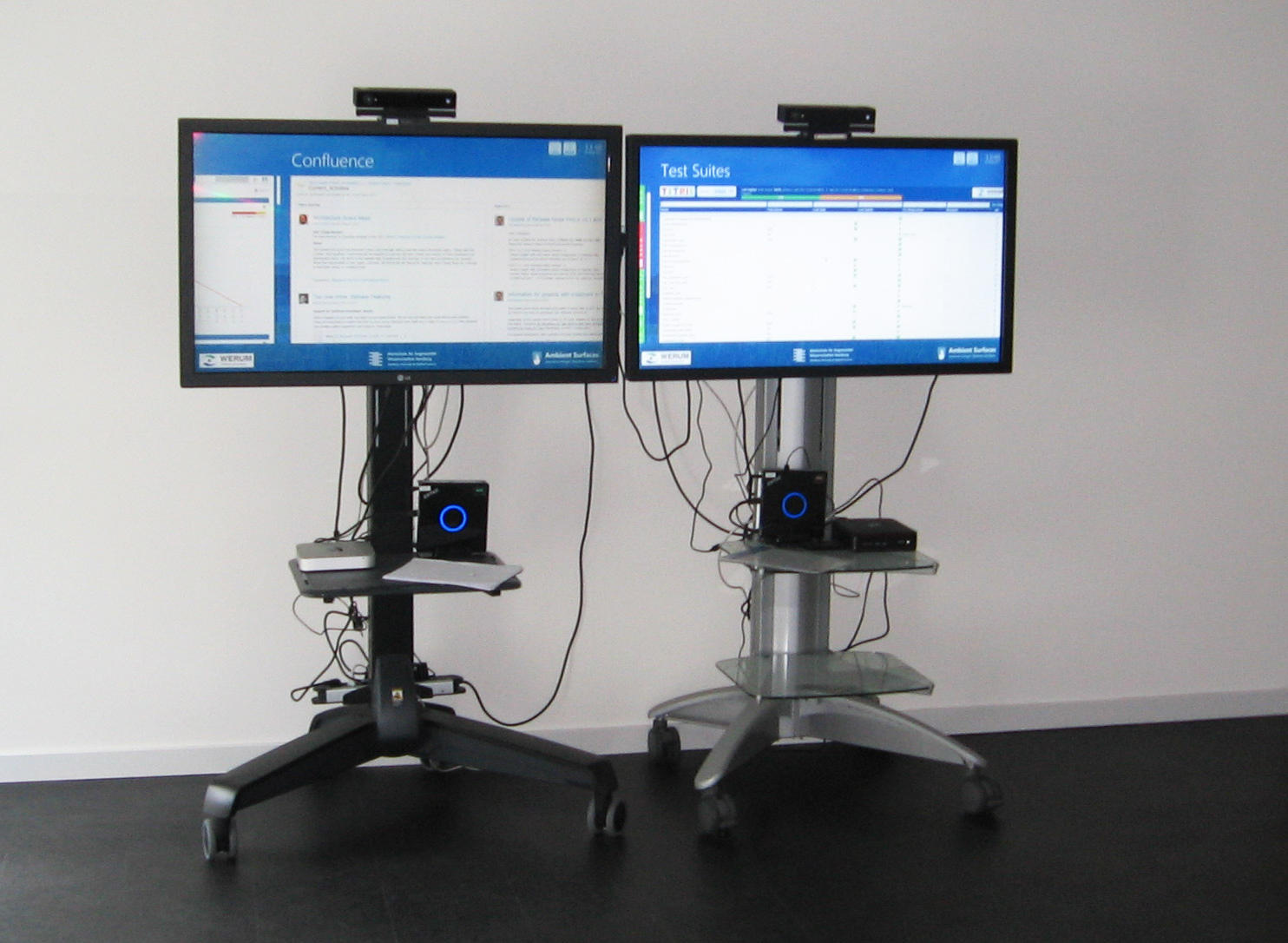Ambient Surfaces

In this project, we have been working on questions regarding our „Ambient Surfaces“ solution since 2012. The project picks up ideas from research into so-called „ambient displays“. These devices principally aim at, on the one hand, to draw people’s attention towards certain information and, on the other hand, a pervasive integration into the natural environment of human beings. To this end, artefacts in the form of haptic objects or large screens are leveraged. Ambient display research originates in thoughts surrounding „Calm Technology“ brought forth by Mark Weiser in the early 1990s.
Our Ambient Surfaces solution has already been used in various real-world contexts, while we put an emphasis on agile software development teams in our research. First general experiences could be made in a four-week field study in 2012. The study was conducted in an IT company in Hamburg. Between 2012 and 2013, two further field deployments were performed in two other companies (an IT company and an IT department of a large insurance company) in Hamburg, which had already been running for a longer period (22 and 36 weeks respectively). This allowed first long-term analyses to be carried out and more in-depth insights into the daily work with these systems to be gained. Subsequently, a field deployment lasting over 5 years (2014–2019) was conducted in collaboration with an IT department of a company in Lüneburg. The aim of this study was to develop an understanding of how such systems are used in the long run.
In the Ambient Surfaces project, we mainly target at the following three topics: firstly, the conduct of additional long-term field deployment studies in authentic environments; secondly, the development of methodological underpinnings to appropriately accompany such studies; and thirdly, we strive towards academic collaborations with other groups in this field.
Selected Publications
Schwarzer, J., Fietkau, J., Fuchs, L., Draheim, S., von Luck, K., Koch, M. (2023). ‘Exploring Mobility Behavior Around Ambient Displays Using Clusters of Multi-dimensional Walking Trajectories’. In Extended Abstracts of the 2023 CHI Conference on Human Factors in Computing Systems (CHI EA ’23). New York, NY, USA: ACM. 6 pages. doi: 10.1145/3544549.3585661.
(Poster: Click here)
Schwarzer, J., Draheim, S., von Luck, K. (2022). ‘Spatial and Temporal Audience Behavior of Scrum Practitioners Around Semi-Public Ambient Displays’. International Journal of Human–Computer Interaction. doi: 10.1080/10447318.2022.2099238.
Schwarzer, J., Draheim, S., von Luck, K., Wang, Q., Grecos, C. (2021). ‘Spontaneous utilization: A classic grounded theory of utilizing ambient displays in professional, large-scale agile software development environments’. International Journal of Human–Computer Interaction, 38(15), pp. 1440–1463. doi: 10.1080/10447318.2021.2002051.
Schwarzer, J., von Luck, K., Draheim, S., and Koch, M. (2019). ‘Towards Methodological Guidance for Longitudinal Ambient Display in Situ Research’. In Proceedings of 17th European Conference on Computer-Supported Cooperative Work – Exploratory Papers. Reports of the European Society for Socially Embedded Technologies (ISSN 2510-2591). doi: 10.18420/ecscw2019_ep07.
Koch, M., von Luck, K., Schwarzer, J., and Draheim, S. (2018). ‘The Novelty Effect in Large Display Deployments – Experiences and Lessons-Learned for Evaluating Prototypes’. In Proceedings of 16th European Conference on Computer-Supported Cooperative Work – Exploratory Papers. Reports of the European Society for Socially Embedded Technologies (ISSN 2510-2591). doi: 10.18420/ecscw2018_3.
Schwarzer, J., Draheim, S., von Luck, K., Wang, Q., Casaseca, P., and Grecos, C. (2016). ‘Ambient Surfaces: Interactive Displays in the Informative Workspace of Co-Located Scrum Teams’. In Proceedings of the 9th Nordic Conference on Human-Computer Interaction. New York, NY, USA: ACM. pp. 69:1–69:4. doi: 10.1145/2971485.2971493.
People

Jan Schwarzer

Susanne Draheim
